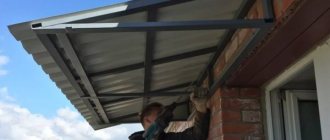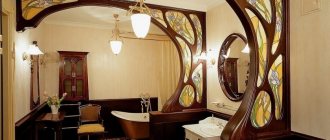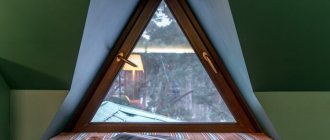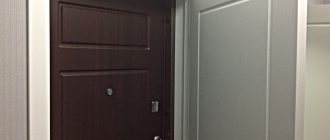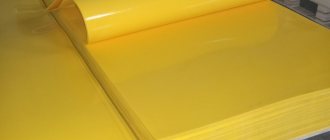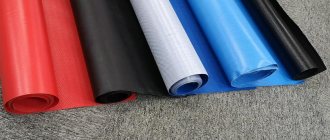Plexiglas is the first transparent polymer, the properties of which made it possible to use it instead of ordinary silicate glass. Despite its advanced age, this material is still widely used in many fields - from medicine to instrument making. It is also often used to make art objects and elements of interior decoration of buildings. But external enclosing structures made of plexiglass are very rare. Although this may seem strange: at the peak of its popularity in the second half of the 20th century, transparent roofs of canopies, greenhouses, canopies, verandas and other similar buildings were often made from plexiglass.
What is the reason for such a sudden lack of demand for plexiglass in this area of construction? And is it worth making a transparent roof out of it now? To answer these questions, let's start from the very beginning - with what plexiglass is in general and what its properties are.
What is plexiglass
Plexiglas is a transparent polymer material obtained from acrylic acid. Hence its second name - acrylic glass. Plexiglas is also sometimes called plexiglass, since in the first years after its development this polymer was produced under the Plexiglas trademark.
Advantages and disadvantages of plexiglass
At the time of its invention - in the 1930s - plexiglass was a real breakthrough. Especially in aviation, although they quickly began to make almost everything from it - from glasses to furniture. They also made roofs from plexiglass - mainly in greenhouses and conservatories.
In general, acrylic glass has become a truly mass-produced material. And not just like that - here are just its main advantages:
- impact strength is 5 times greater than that of ordinary silicate glass;
- translucency up to 92%, which is comparable to the performance of special coated glass;
- does not become cloudy over time;
- UV resistance - no protective coating required;
- low thermal conductivity, which reduces heat loss through transparent structures;
- light weight - about 2.5-3 times lighter than glass;
- thermoplasticity - already at a temperature of 120 °C plexiglass softens;
- preservation of optical properties when changing shape;
- chemical resistance: acrylic glass is resistant to alcohols, mineral oils, fats, alkalis, non-concentrated acids;
- biologically stable;
- ease of processing: plexiglass is easy to cut, weld, and glue;
- frost resistance - can withstand up to -40 °C;
- environmentally friendly material - easily recycled, does not emit toxic substances when burned.
With such characteristics, plexiglass roofs, and any translucent structures made from it, were a good solution. Even more than successful, considering that acrylic glass was cheaper than silicate glass even in the 30s of the last century. And after 10-15 years the difference in price became even multiple.
But this did not last long - until alternatives were invented. And all because of the disadvantages of plexiglass:
- Relatively fragile . Although plexiglass is 5 times stronger than silicate glass, it can still be broken with a strong blow. For example, if an icicle falls on the plexiglass on the roof of the terrace.
- Easily scratched . Yes, plexiglass almost does not degrade over time under the influence of sunlight, but it can still become cloudy due to many scratches on the surface.
- Low softening point . This is both an advantage for molding products and a disadvantage when it comes to enclosing structures. For example, a plexiglass roof rests on a frame, usually metal, which in a hot summer on a sunny day can easily heat up to +80 °C or more.
- Flammability . The most critical disadvantage of plexiglass is its ignition temperature, which is only 260 °C. At the same time, the material burns well even after the source of fire is removed.
It was the flammability of acrylic glass that became the “black mark” of the material. Because of this property, many industries, including aircraft manufacturing, abandoned plexiglass as soon as an alternative appeared in the form of polycarbonate and other more fire-resistant polymer materials.
Types of plexiglass
There are two types of plexiglass for roofing:
- cast (molded), in which the polymer melt is poured into a special mold;
- extrusion (pressed, acrylic glass under pressure) - a material obtained by squeezing the molten mass through rollers or an extrusion head.
Although most of the properties of these two types of plexiglass are identical, there are significant differences that are caused precisely by the method of their production.
Cast plexiglass
Cast plexiglass is considered a more preferable material for a transparent roof than extruded one. This is due to the method of its production: unlike extrusion glass, cast acrylic glass is subjected only to heat treatment without additional pressure. This provides it with the following properties:
- greater impact resistance due to higher molecular weight;
- uniform shrinkage after hardening;
- large possible sheet thickness;
- higher softening temperature (difference with extruded plexiglass is 10-20 °C);
- higher chemical resistance;
- Greater predictability when thermoforming.
Among the disadvantages, it is worth noting the shorter possible length of cast plexiglass, as well as a large error in thickness.
In general, the same rule applies to plexiglass as to other structural polymer materials: cast slabs are better than those obtained by other methods.
Extruded plexiglass
Extruded plexiglass is not as dense as cast glass. And this determines its main properties:
- less impact resistance;
- lower resistance to chemical influences;
- better ability to bond the material;
- lower softening temperature;
- higher shrinkage during thermoforming.
In addition, extruded glass can be much longer than cast glass. In fact, its length is limited only by the size of the workshop. And its thickness is more stable, since the error during extrusion is much smaller than during casting.
It is better not to use extruded slabs as plexiglass for the roof. But they are well suited for the manufacture of interior decoration and multi-component furniture.
legal information
By continuing to use this resource, you acknowledge that you have read the terms and conditions and agree to the rights and obligations described therein. The information posted on the Site is for informational purposes only.
1. Basic provisions
1.1. The Site contains materials that are purely informational in nature.
1.2. The Company reserves the right to change / improve products, services, data presented on the Site without prior notice.
2. Copyright
The information on the Site is the intellectual property of the Company and is protected from piracy (see Russian legislation on copyright and related rights). For forwarding, copying, reproduction, editing or publication on another source, written permission from the Company is required.
3. Privacy Policy
3.1. By leaving your full name, measurement/delivery address, phone number, e-mail and other personal data, you agree to their processing and use by the Company and/or its partners for an unlimited time.
3.2. When processing personal data, the Company relies on the Federal Law “On Personal Data”, the Federal Law “On Advertising” and local regulations.
3.3. Your personal information may be used in the following cases: during registration and then authorization; for the purpose of processing orders; to analyze buyer preferences and carry out personal mailings with recommendations; when the Company promotes its products, as well as collecting data on the operation of the Site, the effectiveness of promotional means; to inform about promotions, discounts and special offers; determining the winner in various promotions from the Company.
3.4. The company undertakes not to transfer received personal information to third parties, except for agents and parties to the contract acting to fulfill obligations to the client.
3.5. The distribution by the Company of client data in an anonymized form for the purpose of assessing and analyzing the operation of the Site and means of promoting goods and services is not considered a violation of the privacy policy.
3.6. The transfer of personal information in accordance with the legislation of the Russian Federation is not considered a violation of these obligations.
3.7. The Company may use “Cookies” technology.
3.8. The company protects personal information from unauthorized access, but is not responsible for data posted by the client in a public form.
3.9. To correct, block or delete personal data, refuse advertising mailings or revoke consent to the processing of personal information, you must send an official request to the Company by email. address
Is it worth making a plexiglass roof?
The answer to this question depends on where exactly you are going to use acrylic glass.
If plexiglass goes on the roof of a terrace or gazebo, remote from the main house , then this is a good solution. In this case, there is no risk of an icicle breaking through the roof, and a fire, if it occurs, is unlikely to spread to a residential building. But the advantages of plexiglass, especially its translucency and lack of degradation over time, will manifest themselves in full force.
But even in this case, you need to use plexiglass specifically for the roof of the terrace. It is not recommended to completely glass a room with it, for example, to make a closed gazebo. In the event of a fire, such a structure will burst into flames almost instantly and will not allow people inside to leave it painlessly and quickly.
If you are going to lay plexiglass on the roof of the veranda or make a transparent atrium roof from it, then this is definitely not worth doing. If acrylic glass catches fire, the fire can easily spread to a residential building, even if it is made of brick, gas block and other non-combustible materials - interior decoration is always suitable for spreading the flame.
If you think that this will not affect you because of a high fence / strict adherence to fire safety rules, then this is a misconception. Plexiglas can easily catch fire from any spark, including small wiring sparks when humidity is high. It burns so well that tourists still use acrylic glass for kindling. Therefore, do not take risks - plexiglass roofs do not belong in close proximity to housing.
Glazing without frame (frameless)
A modern and quite expensive type of veranda glazing, in which everything will be protected by triplex - tempered glass with a huge number of advantages.
- You can create a sun-filled, bright room, as tempered glass transmits light perfectly.
- You will be able to create curved, non-traditional designs.
- The strength of triplex is quite high due to the presence of protective films. So, even with a very strong impact, the glass will not break, but only crack, and this increases the level of safety.
- Externally attractive.
- For ease of entry into the room, you can slide the glass.
Attention! Installing a frameless structure is not an easy task, so try to find competent specialists in this matter.
For clarity, you can watch a video on glazing and views of windows onto the veranda.
Let's sum it up
Plexiglas is the first of the transparent plastics that can be called a full replacement for silicate glass. It is stronger, weighs less, retains heat better, and is easier to mold and process. But at the same time, plexiglass easily becomes covered with surface scratches and burns very well. It was the second property that led to its displacement by other transparent plastics - PVC and polycarbonate.
However, a transparent plexiglass roof can be made. If we are talking about a terrace or gazebo remote from the house. For buildings in the immediate vicinity of housing, plexiglass should not be used.
Installation instructions
Every major manufacturing company offers customers installation services for supplied products. Professionals work in accordance with the technological map and provide a long-term guarantee for the result.
If the owner of a property makes an independent decision to install wooden windows on the veranda, he must sequentially complete the following stages of work:
The opening intended for installing a window is cleaned of dust and dirt and leveled.- The window structure is freed from glass and sashes.
- The frame is installed in the opening on spacer plates and wedged into the body of the enclosing structure.
- Vertical and horizontal mullions are leveled and then fixed with self-tapping screws through mounting plates
- All fixed glazing parts are mounted into a fixed frame, pressed with wooden glazing beads and sealing tapes.
- The gaps between the supporting frame profile and the end edges of the opening are filled with polyurethane foam.
- Pre-assembled opening sashes are hung into the frame openings, after which they are subject to adjustment.
- At the final stage, flashings, flashings, frames and window sill boards covering the mounting slots are installed.
When the work is completed, it is necessary to check the quality of installation of the structure and the accuracy of the adjustment of each sash.
From the video you will learn how to glaze a veranda with your own hands:
The veranda in a private house is more relevant than ever
The relevance of increasing the usable area of a country house or cottage during the coronavirus pandemic has increased sharply. Each family member needs a separate room or office for studying or working outside the city. The emergency situation became a catalyst for the implementation of long-planned plans - the construction of a veranda.
The dream veranda is an extension to the house, a connecting link between the living space and the street. The building serves as a vestibule, main entrance, recreation area, and is a continuation of the house. The room, on the one hand, is protected from rain and bad weather and prevents frosty air from entering the house. On the other hand, you can feel unity with nature in it: birdsong, sunsets and sunrises, the drumming of rain. Panoramic glazing and the ability to open the opening as much as possible make the veranda a favorite place to relax for the whole family. It is important that such a design is comfortable and lasts for many years. Modern technologies make it possible to make verandas from warm aluminum, with a 360-degree panorama, that will last more than 80 years.
The existing “wooden” stereotype for building verandas is morally and physically outdated. And over time, it will leave suburban housing construction. The construction of a glazed veranda made of wood and aluminum differs significantly in technology. Let's figure it out.
Average prices
Competition between manufacturers in the market leads to the leveling of the average price for all wooden window structures for the veranda:
Cold single glass in pine profile – from 4 – 7 thousand rubles. for 1 m2.- Warm double-glazed windows in a thickened frame – from 9 – 11 thousand rubles. for 1 m2.
- Tempered glass for panoramic viewing – from 13 – 14 thousand rubles. for 1 m2.
- Availability of opening doors – from 10 – 12 thousand rubles. for 1 m2.
- Non-standard panoramic designs – from 15 – 20 thousand rubles. for 1 m2.
Note! When choosing a more valuable type of wood - oak, larch or red meranti, the cost of the structure can increase by 30% - 100%.


